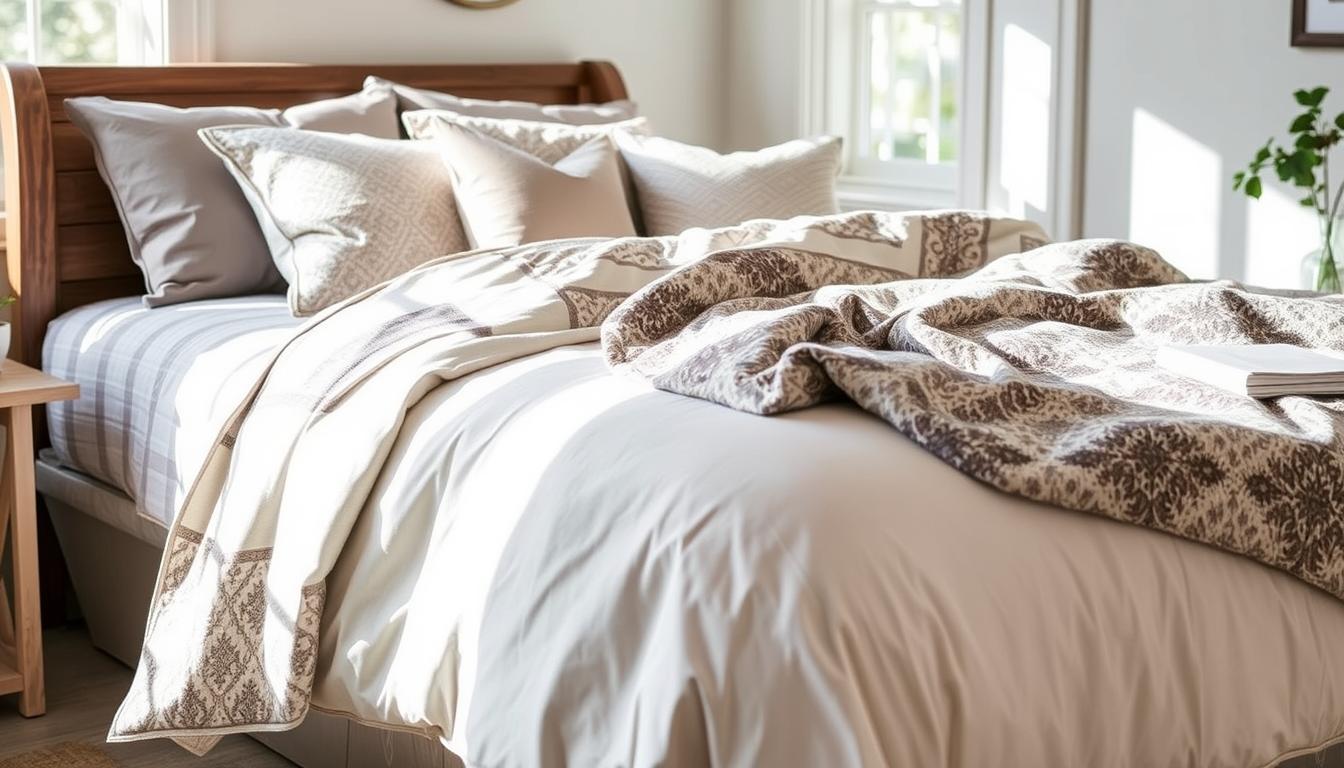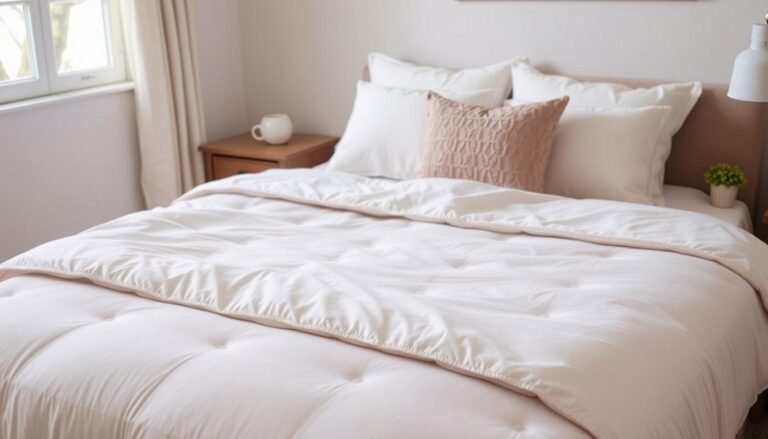Using a Duvet Cover as a Bedspread: Pros and Cons.
Choosing the right bedding can be tough with so many choices. You might wonder, can a duvet cover work as a bedspread? The answer is yes. Duvet covers as bedspreads can be a modern choice that combines fashion and function.
Duvets have become popular in the U.S in the last 20 years. They are loved for their versatility and easy care. They are easier to wash than bulky comforters and quilts.
Comforters stand out for their trendy materials and are common in many homes. Quilts bring a special charm with their detailed work, perfect for craft lovers. Bedspreads used to be a hotel favorite, but are now less common in homes.
So, is a duvet cover good enough to replace a traditional bedspread? This article will guide you through using duvet covers as bedspreads. You’ll learn the pros and cons to see if it’s right for you.
What is a Duvet Cover?
A duvet cover is both a decorative and a protective layer for the duvet insert. Originating from France, a duvet usually has down, feathers, or synthetic fibers inside. It is a soft, flat bag. The cover not only makes your bed look better but also keeps the insert free from dust and stains. Duvet covers can be more than just protection. They can also be a light blanket or a part of your bedroom’s theme.
Differences Between a Duvet, Duvet Cover, and Comforter
It’s important to know the difference between a duvet, a duvet cover, and a comforter when choosing your bedding. Duvets might be used with a cover or just with a sheet. The duvet cover encloses the duvet and hangs over the bed’s sides, giving a classy look. In contrast, comforters are one-piece blankets with stitching to evenly spread the filling.
Some like using a duvet cover as a standalone blanket. It simplifies bed-making and keeps you comfy. This makes duvet covers a smart choice for stylish and practical bedspread ideas.
Materials Used in Duvet Covers
Materials for duvet covers are wide-ranging, satisfying various tastes and needs. Cotton and silk are loved for their softness and breathability, perfect for any season. Conversely, synthetic fibers score points for being strong and budget-friendly, making them good for cost-saving decor.
Duvet covers also come in different fabrics like sateen, percale, and linen. Sateen feels luxurious and silky, while percale is cool and crisp. Linen offers durability and a casual, relaxed vibe, great for a laid-back style. These fabrics enhance comfort and the look of your room, playing a crucial role in bedroom decor.
Choosing the right duvet cover can make your bedroom both stylish and comfy. Whether you stick to traditional uses or get creative, duvet covers open up many options for improving your sleep space.
Pros of Using a Duvet Cover as a Bedspread
Choosing a duvet cover as a bedspread brings many benefits. It’s versatile, easy to care for, and cost-effective. Switching up your bedroom look is easy with a different duvet cover. Let’s dive into the key advantages of using a duvet cover on your bed.
Versatility in Design
Duvet covers are great for changing your bed’s look easily. They come in many styles, colors, and patterns. This makes them perfect for anyone wanting to refresh their bedroom decor regularly. Duvet covers offer a simple yet effective way to keep your bedroom looking fresh.
Easy to Clean
Keeping your bed clean and cozy is easier with a duvet cover. They are machine washable, which means less hassle. You won’t need to wash heavy comforters or duvets often. Experts suggest having several duvet covers to switch them out and maintain a neat, inviting bedroom.
Cost-Effective Option
Using a duvet cover as a bedspread saves money. They are less expensive than full comforter sets. This makes refreshing your bedroom’s look more affordable. It’s a smart choice for anyone wanting to change their bedding regularly without spending too much, making it a great addition to your bedroom essentials.
| Aspect | Details |
|---|---|
| Design Variety | Wide range of styles, colors, and patterns |
| Easy Maintenance | Machine washable |
| Cost | More affordable than full comforter sets |
Cons of Using a Duvet Cover as a Bedspread
Using a duvet cover as a bedspread has its downsides. It’s important to think about certain challenges. These include the effort it takes to put a duvet inside, how hot it can get, and the cost at the beginning. Knowing these drawbacks helps you decide what’s best for your room.
Challenges in Inserting the Duvet
Putting in a duvet is often seen as tough. It can be hard and annoying, especially with a big and bulky insert. In places like Scandinavia, they use ties inside the corners to hold the duvet. Even with these tips, it’s still not easy to get the duvet just right. This can make people think twice about choosing a duvet cover.
Potential for Excess Warmth
Using a duvet cover can also make you too warm. This is a problem in hot weather or for those who live in warm areas. Duvet inserts made of heavy materials like down can get too hot. Even duvet covers made of linen that adjust to your temperature might not be enough. If you easily get hot, you might prefer something lighter, like a quilt.
Initial Cost Considerations
The first cost of buying a duvet cover and insert is high. High-quality duvet covers and inserts cost more than simpler bedding like comforters. Comforters, with their own filling, don’t need an extra cover or insert. This makes them a cheaper option for people watching their budget. Also, keeping a duvet cover clean, which is needed every week or two, can add more costs.
In the end, choosing between a duvet cover and other bedding depends on what looks good, feels comfortable, and is practical. These tips can help you make a smarter choice. They show the good and the bad of each option. If you want to know more about bedding choices, check out this informative resource.
Can You Use a Duvet Cover as a Bedspread?
Many wonder if it’s good to use a duvet cover as a bedspread. Around 40% of Americans prefer a duvet to a top sheet. Duvet covers are liked for being easily changeable. They come in many materials, styles, colors, and designs.
Using a duvet cover as a bedspread is easier to maintain. It’s not bulky and easier to wash than bedspreads. This choice is cleaner for those ditching the top sheet. It makes dealing with heavy, difficult bedspreads unnecessary.
Duvet covers offer great design flexibility. They can be swapped unlike traditional bedspreads, matching your room’s look anytime. You can pick from vibrant designs or soothing tones to match your taste.
Duvet covers can keep you warm, perfect for chilly nights. Comforters are different, providing warmth with unique patterns. They don’t need covers.
Beddley makes a unique duvet cover with a three-sided zipper. It’s easy to use and keeps the comforter in place. This saves time and simplifies making the bed. Learn more about Beddley’s invention here.
The choice between a duvet cover and a bedspread depends on what you like. Some prefer the classic look and feel of bedspreads. Others enjoy the ease and style of duvet covers. Knowing about their care, use, and looks helps you choose what’s best for your room.
Duvet Cover vs. Bedspread: Key Differences
Choosing between a duvet cover and bedspread involves many factors. Some of these include aesthetic appeal, practicality, and comfort. Each option has its own pros, depending on your bedroom’s look and your personal taste. Let’s compare them closely so you can decide what’s best for you.
Design and Aesthetic Appeal
Duvet covers and bedspreads have different styles. Duvet covers are modern and simple. They come in many patterns and colors, allowing for easy style changes. Bedspreads have a classic look, reaching the floor with detailed designs. Learn more about these differences here.
Practicality and Usability
Practicality is key when picking bedding. Duvet covers are washable and fit for busy homes. Bedspreads don’t need a heavy duvet inside, making them simpler to use. Yet, they often need professional cleaning.
Comfort and Warmth
The choice also affects your comfort levels. Duvets are cozy, great for cold places. They’re stuffed with warm materials. Bedspreads are lighter, perfect for hot weather or summer nights. They work with other bedding to adjust warmth. Surprisingly, a duvet cover can be a light bedspread in warm months, showing its versatility.
This info will guide you in choosing. It helps decide if a duvet cover or a classic bedspread fits your life better.
Duvet Cover Alternatives for Bedding
Looking beyond duvet covers for bedding? Consider comforters, quilts, and bedspreads. Each one offers something special in style, comfort, and cost. They meet various preferences and needs. So, you can find the best fit for your bedroom and lifestyle.
In the US, comforters are a go-to for many. They come in bedding sets and have less fill than duvets. But, they might get less warm over time because of washing. They’re also a bit tricky to update style-wise. Yet, they offer ease of use for those who like things simple. Remember, their fill can flatten after washing, impacting durability.
Quilts add a touch of decor and history. Their prices range from $50 to $1000, depending on if they’re store-bought or handmade. With care, they can last for years. While not as warm as duvets, quilts enhance the look and feel of a room.
Bedspreads are an affordable, light option. They cost up to $500 and are easy to take care of. But, they might only last 2 to 5 years. This makes them less durable than duvets, which can go up to 25 years. Duvets are a more significant, long-lasting investment.
So, each alternative to duvet covers has unique benefits. Comforters, quilts, and bedspreads suit different tastes and needs. Think about style, comfort, maintenance, and how long they’ll last. This way, you can pick the perfect bedding for your room.

Hey there, I’m Alex Hanson and I’m passionate about all things covers! Whether you’re looking for a car seat cover to protect your vehicle or an oven cover to keep your kitchen clean, I’m here to help. With years of experience in the industry, I have plenty of knowledge and insights to share with my readers. So, if you care about protecting your belongings and making them look their best, you’re encouraged to read my blog as I explore the perfect cover for every need.


